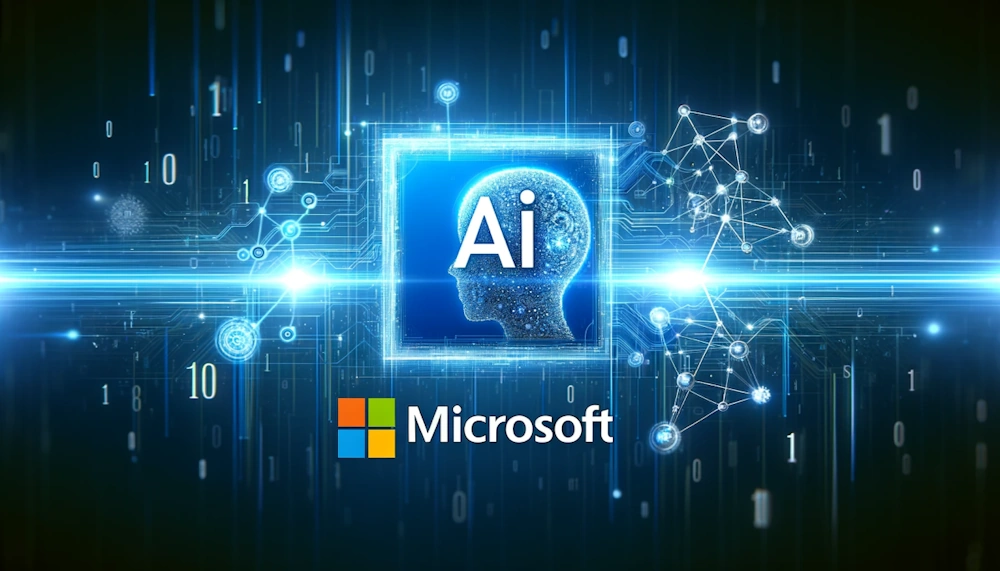 Microsoft
Microsoft
Early investor in research and AI
In 1975 Bill Gates confronted his family--father, mother, and sister--about his decision to drop out of Harvard to start a software company with Paul Allen. The background was the release of the first personal computer, destined to change the course of computing by bringing computers into the home.
Gates' family wanted him to stay in college, but Bill felt strongly that he needed to pursue his career interests at that precise moment in time. The MITS Altair 8800 had recently been introduced and Gates, like Steve Jobs with Apple, believed he should seize the day, even if that meant he had to drop out of Harvard. This moment was crucial because it allowed Gates to fully dedicate himself to Microsoft, which became one of the most influential tech companies in history. Had he stayed in school, the trajectory of personal computing might have been different.
The Gates' family decided to support Bill's decision to leave Harvard and pursue Microsoft. His father, a lawyer, reviewed all Microsoft contracts. His mother had connections to IBM through her work with the United Way, which later helped Microsoft secure a monumental deal for the operating system that became the Microsoft Disk Operating System or MS-DOS.
The IBM-Microsoft deal is one of the most important moments in tech history, for it involved a crucial decision to use Microsoft's DOS program instead of Gary Kildall's Control Program for Microcomputers (CP/M), the leading operating system at the time, for IBM's first personal computer, the IBM PC. IBM's choice of Microsoft over CP/M shaped the entire PC industry. Had Kildall struck the deal instead, Microsoft might never have become the giant it did, and the tech landscape could look very different today.

Microsoft's agreement with IBM had two critical clauses that shaped the future of computing. The first is Non-Exclusive Licensing, meaning Microsoft retained the right to sell MS-DOS to other companies, while IBM got its own branded version called PC-DOS. This meant when IBM PC clones from Compaq, Dell, and others exploded in the 1980s, they all paid Microsoft--not IBM--for DOS. Secondly, there was a Per-Copy Royalty clause. IBM paid Microsoft a small royalty ($1 to $5 per copy) for every PC sold with DOS. Over time, as the IBM PC became the industry standard, this turned into billions in revenue for Microsoft.
IBM believed the deal was just about licensing an OS for its hardware. They didn't foresee the clone market, so they didn't demand exclusivity. Meanwhile, Microsoft kept full control of the software rights. IBM thought hardware was king, for they assumed profits would come from selling PCs. Microsoft bet on software and structured the deal so that even IBM's competitors would pay Microsoft. By the late 1980s, MS-DOS was on nearly every PC, while IBM's control over the PC market eroded, primarily due to lower cost competitors. IBM sold its PC division to Lenovo in 2005, marking the end of an era for the company that invented the modern personal computer.
IBM PCs and clones dominated, but Microsoft made the money from licensing. By 1990, Microsoft had 95% of the PC OS market, thanks to DOS and later Windows. IBM eventually tried to regain control with their own OS/2 operating system, but it was too late; Microsoft won, software defeated hardware, David had beaten Goliath, and Bill Gates' decision to leave Harvard was vindicated.
 Microsoft AI
Microsoft AI
Microsoft began its journey in AI much earlier than many people realize. While Microsoft has been involved in AI research since the 1990s, its major push into mainstream AI began around 2016, accelerating with its OpenAI partnership and the integration of generative AI into its products. Here's a timeline of key milestones:
Early Foundations (1990s-2010s)
Founded in 1991, with AI as one of its core focus areas, Microsoft Research (MSR) is one of the world's most influential corporate research labs. It is responsible for foundational advancements in AI, systems, human-computer interaction, and theoretical computer science. MSR was founded by Nathan Myhrvold, a former Microsoft Chief Technology Officer, and Bill Gates, who wanted to create a "Bell Labs for software." An international enterprise, the first labs were located in Redmond, Washington (the headquarters), with branches in Cambridge, and Beijing. It was later expanded to include New York City, Montreal, Africa, and more. The early focus was on operating systems (Windows NT kernel optimizations), programming languages like C# and F#, and early AI, including machine learning and speech recognition.
![]()
Introduced in Microsoft Office 97 at its officially launch in 1998, Clippy was an animated paperclip designed as an interactive help assistant for Office users. Though meant to be helpful, it became one of the most disliked features in software history, a symbol of bad user-interface design. Clippy was an AI-powered, rule-based helper that popped up to offer tips in Word, Excel, and PowerPoint. Besides Clippy, users could choose other assistants like Rover the dog, Merlin the wizard or Links the Cat.
Clippy worked as rule-based AI, not machine learning, using scripted responses such as "It looks like you're writing a letter. Would you like some help?". It was triggered by keywords, like typing "Dear" implies a letter-writing tip. Clippy had no real intelligence, for it couldn't learn from users, it just followed pre-programmed rules. Unfortunately, it often interrupted work with irrelevant and annoying suggestions.
Learn more about Microsoft Research:
- researchforum.microsoft.com
- microsoft.com/en-us/research/publications
- microsoft.com/en-us/research/tools
- microsoft.com/en-us/research/blog
- microsoft.com/en-us/research/focus-area/ai-and-microsoft-research
MSR on machine learning, natural language processing, and computer vision
In the 2000s, MSR made significant contributions to machine learning, natural language processing, and computer vision, paving the way for many modern AI advancements at Microsoft. Technologies developed during this period influenced Microsoft products like Bing search, Cortana assistant, Kinect for Xbox, Translator, and more.
In machine learning, MSR researchers worked on boosting algorithms such as Microsoft's LightGBM, later developed in the 2010s, and built on earlier gradient boosting research. Large-scale training optimizations for machine learning models were achieved which improved efficiency in distributed computing. Using Bayesian methods and graphical models, work on probabilistic models and structured prediction influenced later developments in deep learning.
In natural language processing, MSR was a leader in Statistical Machine Translation (SMT), a cornerstone of the 2007 release of the Microsoft Translator product. Research on phrase-based translation and alignment models helped improve accuracy. MSR researchers also explored n-gram language models, web-scale data-driven NLP, Latent Semantic Analysis (LSA), made topic modeling advancements, and contributed to Hidden Markov Models (HMMs) research.
MSR conducted computer vision research on feature extraction in object recognition before deep learning took over. Microsoft developed real-time face detection algorithms used in products like the 2010 Kinect for Xbox 360, and they conducted research on graph cuts and Markov Random Fields (MRF) for image segmentation and stereo vision, technologies that found their way into future Microsoft products.
 Major AI Investments (2010-2016)
Major AI Investments (2010-2016)
Cortana was a virtual assistant developed by Microsoft that used the Bing search engine to perform tasks such as setting reminders and answering questions for users. Cortana was integrated into the Microsoft Ecosystem as it was built into Windows 10, Xbox, Office 365, and the Microsoft Edge browser. Cortana could perform tasks like setting reminders, sending emails, answering Bing search queries, and controlling smart home devices using its IoT integration.
While it emerged in the 2010s, its underlying technologies of natural language processing, speech recognition, and machine learning, were heavily influenced by work done by MSR in the 2000s. Cortana was discontinued as a standalone app in Windows 11. Cortana's legacy is that it paved the way for Microsoft's newer AI efforts like Copilot, which is powered by OpenAI GPT, and it helped advance conversational AI research at Microsoft.
- 2014: Microsoft CEO Satya Nadella emphasized AI as a key priority, leading to increased investments.
- 2016: Microsoft launched Microsoft AI and Research Group, consolidating AI efforts under Harry Shum.
- 2016: Microsoft acquired SwiftKey, an AI-powered keyboard app, and Maluuba, a deep learning and natural language processing startup.
 AI Expansion and Breakthroughs (2017-Present)
AI Expansion and Breakthroughs (2017-Present)
Microsoft's recent challenges include balancing AI infrastructure demands with profitability and navigating regulatory issues over acquisitions. However, its investments in cloud, gaming, and AI ensure it remains a dominant force in tech. Azure AI has became the backbone of Microsoft's growth.
- 2017: Microsoft launched Azure AI, integrating AI into cloud computing.
- 2018: Microsoft acquired GitHub, leveraging AI for code suggestions, later leading to GitHub Copilot in 2021.
- 2019: Microsoft invested $1 billion in OpenAI, forming a strategic partnership, subsequently expanded to $10 billion in 2023.
- 2020: Microsoft launched Turing Natural Language Generation (T-NLG), a precursor to modern large language models.
- 2023: Microsoft integrated OpenAI's GPT-4 into Bing Chat, later rebranded as Copilot, and across Office 365 (Microsoft 365 Copilot).
- 2024: Microsoft continued expanding AI in Windows (Copilot+ PCs) and Azure AI services.
